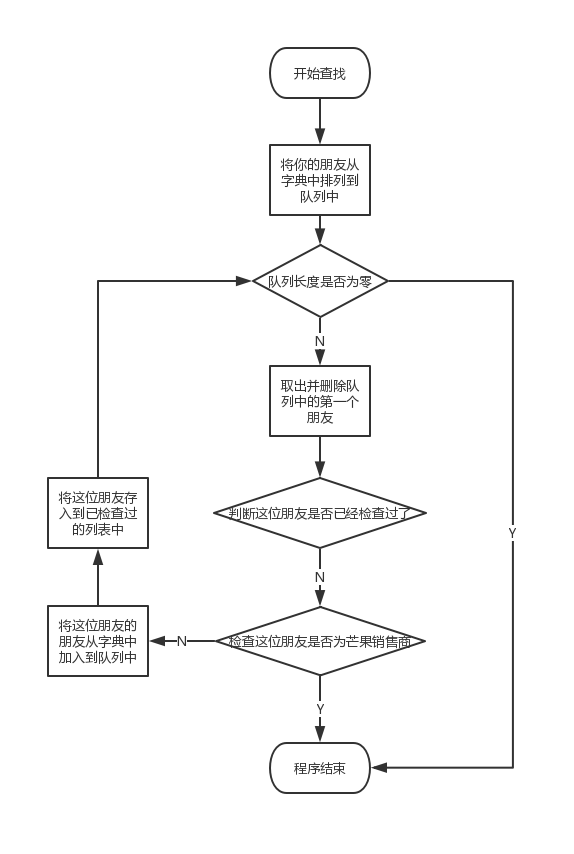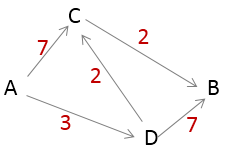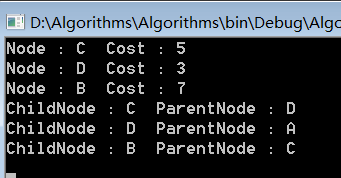BFS可回答两类问题:
1.从节点A出发,有前往节点B的路径吗?
2.从节点A出发,前往节点B的哪条路径经过的节点最少?
BFS中会用到“队列”的概念。队列是一种先进先出(FIFO, first in first out)的数据结构,与栈不同,栈是后进先出(LIFO, last in first out)的数据结构。
还会用到“字典”的概念。字典在现在很多语言中都存在且广泛使用,字典中的元素是一组<键(key),值(value)>对,key的值是不可以重复的。关于字典的详细内容,网上有很多资料可以查阅。
问题描述:想从你的朋友中找出一个芒果销售商,如果你的朋友中没有,那么就从朋友的朋友中查找。(这里假设名字最后一个字母为“m”的即为芒果销售商)。这样就是从“you”这个节点出发,是否有到“Xm”这个节点的路径的问题。
思路:先从你的朋友开始查找,如果朋友A是芒果销售商,则程序结束,如果不是,则将A的朋友排到队列中。然后检查朋友B是否为芒果销售商,循环,直到找到芒果销售商或者队列中的朋友们都被检查了一遍。因为会有某个人C既是A的朋友又是B的朋友,而C只需要检查一次,因此要分配一个列表用于记录已经检查过哪些朋友了。

Python代码:
>>> from collections import deque >>> graph = {} >>> graph["you"]=["alice","bob","claire"] >>> graph["bob"] = ["anuj","peggy"] >>> graph["alice"] = ["peggy"] >>> graph["claire"]=["thom","jonny"] >>> graph["anuj"]=[] >>> graph["peggy"]=[] >>> graph["thom"]=[] >>> graph["jonny"]=[] >>> def search(name): search_queue = deque() search_queue += graph[name] searched = [] while search_queue: person = search_queue.popleft() if person not in searched: if person_is_seller(person): print (person + " is a mango seller!") return True else: search_queue += graph[person] searched.append(person) return False >>> def person_is_seller(name): return name[-1] == 'm' >>> search("you") thom is a mango seller! True
C#代码:
namespace Algorithms { public static class BFS { public static bool BreadthFirstSearch(string name, Dictionary<string,List<string>>graph) { Queue<string> search_queue = new Queue<string>(); foreach (var item in graph[name]) search_queue.Enqueue(item); List<string> searched = new List<string>(); while (search_queue.Count != 0) { string person = search_queue.Dequeue(); if (!searched.Contains(person)) { if (JudgeSeller(person)) { Console.WriteLine(person + " is a mango seller!"); return true; } else { foreach (var item in graph[person]) search_queue.Enqueue(item); searched.Add(person); } } } return false; } private static bool JudgeSeller(string name) { if (name[name.Length - 1] == 'm') return true; return false; } } }
测试:
namespace Algorithms { class Program { static void Main(string[] args) { Dictionary<string, List<string>> graph = new Dictionary<string, List<string>>(); graph["you"] = new List<string>() { "alice", "bob", "claire" }; graph["alice"] = new List<string>() { "peggy" }; graph["bob"] = new List<string>() { "anuj", "peggy" }; graph["claire"] = new List<string>() { "thom", "jonny" }; graph["anuj"] = new List<string>(); graph["peggy"] = new List<string>(); graph["thom"] = new List<string>(); graph["jonny"] = new List<string>(); if (!BFS.BreadthFirstSearch("you", graph)) { Console.WriteLine("no mango seller!"); } Console.Read(); } } }
Dijkstra's algorithm 用于计算出最短路径,但是这个算法在使用上有很多限制条件。
问题描述:从A地到B地的各种可能的路径中,哪条路径所用的时间最短。(图中的数字表示从某地到另外某地所用的时间)

图1
思路:记录从A点到其他各个节点的所需的时间,如表1所示(现在还不知道从A到B的时间,则先设置为无穷大)
| D | 3 |
| C | 7 |
| B | ∞ |
表1
从所需时间最短的D点再出发,计算从A经过D到其他个各节点的时间,如表2所示
| C | 5 |
| B | 10 |
表2
直接前往C点需要的时间为7,而经过D点前往C点所需的时间为5,时间缩短了,则更新从A到各个点所需的时间的列表,如表3所示
| D | 3 |
| C | 5 |
| B | 10 |
表3
现在除了节点D之外,从A到C的时间是最短的了,则计算从A经过C再到其他节点的时间,如表4所示。
| B | 7 |
表4
现在从A经过D再经过C然后到B的时间为7,小于表3记录的到B的时间,则更新这个时间。
就这样得到了花费时间最短的路径。总结一下就是,不断的获得从起点到某点的最短时间,然后更新这个时间列表。在 Dijkstra's algorithm中,这些数字被称为“权重(weight)”,而带权重的图则被称为加权图(weighted graph),那么不带权重的则被称为非加权图(unweighted graph)。对于计算非加权图中的最短路径,可使用BFS,计算加权图中的最短路径,可使用 Dijkstra's algorithm。然而, Dijkstra's algorithm不适用于带环的图,即图1中的箭头如果是双向的话那么就是不适用的。此外,它还不适用于带有负权重的情况。
Dijkstra算法的实现需要使用三个散列表。第一个散列表记录的是每个点的邻居及权重。第二个散列表记录的是从起点开始到每个节点的权重,第三个散列表记录的是各个节点父节点。
Python代码:
#第一个散列表,记录每个点的邻居及权重 graph={} graph["A"]={} graph["A"]["C"]=7 graph["A"]["D"]=3 graph["C"]={} graph["C"]["B"]=2 graph["D"]={} graph["D"]["C"]=2 graph["D"]["B"]=7 graph["B"]={} #第二个散列表,记录从起点A到其他各个节点的权重 #由于节点B不是A的邻居,则A到B的权重暂设置为无穷大 costs={} infinity = float("inf") costs["C"]=7 costs["D"]=3 costs["B"]=infinity #第三个散列表,用于存储节点的父节点 parents={} parents["C"]="A" parents["D"]="A" parents["B"]=None #用于记录已经处理过的节点的数组 processed=[] #先在未处理的节点数组中找到权重最小的节点 def find_lowest_cost_node(costs): lowest_cost = float("inf") lowest_cost_node = None for node in costs: cost = costs[node] if cost < lowest_cost and node not in processed: lowest_cost = cost lowest_cost_node = node return lowest_cost_node node = find_lowest_cost_node(costs) while node is not None: cost = costs[node] neighbors=graph[node] for n in neighbors.keys(): new_cost=cost + neighbors[n] if costs[n] > new_cost: costs[n] = new_cost parents[n]=node processed.append(node) node=find_lowest_cost_node(costs) for node in costs: print("Node:" + node+ " Cost:" + str(costs[node]) + " ") for node in parents: print("ChildNode:" + node + " ParentNode:" + parents[node] + " ")
运行结果:
Node:C Cost:5 Node:D Cost:3 Node:B Cost:7 ChildNode:C ParentNode:D ChildNode:D ParentNode:A ChildNode:B ParentNode:C >>>
C#代码:
public class DijkstraAlgorithm { public Dictionary<string, double> Costs { get; set; } public Dictionary<string, string> Parents { get; set; } public Dictionary<string, Dictionary<string,double>> Graph { get; set; } private List<string> processed = new List<string>(); public DijkstraAlgorithm() { Costs = new Dictionary<string, double>(); Parents = new Dictionary<string, string>(); Graph = new Dictionary<string, Dictionary<string, double>>(); } public void Dijkstra_Algorithm() { string node = FindLowestCostNode(); while(node != null) { double cost = Costs[node]; Dictionary<string, double> neighbors = Graph[node]; foreach(KeyValuePair<string,double> item in neighbors) { double new_cost = cost + item.Value; if (Costs[item.Key] > new_cost) { Costs[item.Key] = new_cost; Parents[item.Key] = node; } } processed.Add(node); node = FindLowestCostNode(); } } private string FindLowestCostNode() { string lowestcostnode = null; double lowestcost = double.PositiveInfinity; foreach(KeyValuePair<string,double> item in Costs) { if(item.Value < lowestcost && !processed.Contains(item.Key)) { lowestcost = item.Value; lowestcostnode = item.Key; } } return lowestcostnode; } }
字典的初始化以及运行结果:
DijkstraAlgorithm Dalgorithm = new DijkstraAlgorithm(); Dalgorithm.Graph["A"] = new Dictionary<string, double>(); Dalgorithm.Graph["A"]["C"] = 7; Dalgorithm.Graph["A"]["D"] = 3; Dalgorithm.Graph["C"] = new Dictionary<string, double>(); Dalgorithm.Graph["C"]["B"] = 2; Dalgorithm.Graph["D"] = new Dictionary<string, double>(); Dalgorithm.Graph["D"]["C"] = 2; Dalgorithm.Graph["D"]["B"] = 7; Dalgorithm.Graph["B"] = new Dictionary<string, double>(); Dalgorithm.Costs["C"] = 7; Dalgorithm.Costs["D"] = 3; Dalgorithm.Costs["B"] = double.PositiveInfinity; Dalgorithm.Parents["C"] = "A"; Dalgorithm.Parents["D"] = "A"; Dalgorithm.Parents["B"] = null; Dalgorithm.Dijkstra_Algorithm(); foreach(KeyValuePair<string,double> item in Dalgorithm.Costs) { Console.WriteLine("Key : " + item.Key + " Value : " + item.Value); } foreach(KeyValuePair<string,string> item in Dalgorithm.Parents) Console.WriteLine("Key : " + item.Key + " Value : " + item.Value); Console.Read();
